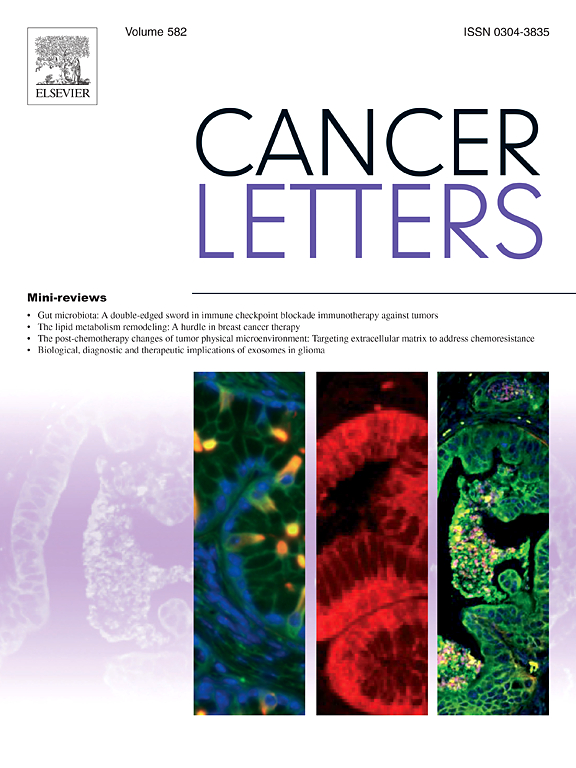The nuclear condensates of ESE3/EHF induce cellular senescence without the associated inflammatory secretory phenotype in pancreatic ductal adenocarcinoma
IF 9.1
1区 医学
Q1 ONCOLOGY
引用次数: 0
Abstract
Senescent cells are in a stable state of cell cycle arrest, leading to a natural barrier to tumorigenesis. Senescent cells secrete a pool of molecules, including cytokines, chemokines, proteases, and growth factors, termed the senescence-associated secretory phenotype (SASP), paradoxically contributing to pro-tumorigenic processes. However, the mechanism for regulating senescence and SASP in tumor cells remains unclear. Here, SPiDER senescence probe-based CRISPR/Cas9 library screening has identified ETS homologous factor (EHF) could effectively induce cellular senescence but without SASP, which could further significantly inhibit PDAC progression. Mechanically, tumoral EHF could form liquid-like condensates and further transcriptionally repress the expression of telomerase reverse transcriptase (TERT) and associated inflammatory factors, such as IL-6, CXCL12, etc. The reduction of TERT led to the telomere shortening and dysfunction of cancer cells, which further drove cellular senescence in PDAC. Moreover, EHF-mediated repression of inflammatory factors effectively declined the infiltration of immunosuppressive cells including MDSCs, Tregs, neutrophils, and promoted the accumulation of CD8+T cells and NK cells, which enhanced tumor immune surveillance. Furthermore, high throughput drug screening identified that Bilobetin could effectively promote the phase separation of EHF, which could further induce tumoral senescence but without SASP. In vivo, preclinical translational research uncovered that Bilobetin could ameliorate immunosuppressive tumor microenvironment (TME) and sensitize PDAC to anti-PD-1 therapy. Overall, our study revealed EHF as a potential candidate to overcome the paradoxical function of cellular senescence and elucidated the effects of its phase separation state on gene regulation, which provided new insights and strategies for PDAC treatment.

ESE3/EHF核凝聚体在胰腺导管腺癌中诱导细胞衰老,而不伴有炎症分泌表型。
衰老细胞处于细胞周期停滞的稳定状态,导致肿瘤发生的自然屏障。衰老细胞分泌一系列分子,包括细胞因子、趋化因子、蛋白酶和生长因子,被称为衰老相关分泌表型(SASP),矛盾地促进了促肿瘤的过程。然而,调控肿瘤细胞衰老和SASP的机制尚不清楚。本文通过基于SPiDER衰老探针的CRISPR/Cas9文库筛选,发现ETS同源因子(EHF)可以有效诱导细胞衰老,但不含SASP,进一步显著抑制PDAC进展。机械上,肿瘤EHF可形成液体状凝聚物,进一步转录抑制端粒酶逆转录酶(TERT)及相关炎症因子如IL-6、CXCL12等的表达。TERT的减少导致癌细胞端粒缩短和功能障碍,进一步推动PDAC细胞衰老。此外,ehf介导的炎症因子抑制有效地降低了MDSCs、Tregs、中性粒细胞等免疫抑制细胞的浸润,促进了CD8+T细胞和NK细胞的积累,增强了肿瘤的免疫监视能力。此外,高通量药物筛选发现Bilobetin可有效促进EHF相分离,进一步诱导肿瘤衰老,但不存在SASP。在体内,临床前转化研究发现Bilobetin可以改善免疫抑制性肿瘤微环境(TME),并使PDAC对抗pd -1治疗敏感。总之,我们的研究揭示了EHF作为克服细胞衰老悖论功能的潜在候选,并阐明了其相分离状态对基因调控的影响,为PDAC的治疗提供了新的见解和策略。
本文章由计算机程序翻译,如有差异,请以英文原文为准。
求助全文
约1分钟内获得全文
求助全文
来源期刊

Cancer letters
医学-肿瘤学
CiteScore
17.70
自引率
2.10%
发文量
427
审稿时长
15 days
期刊介绍:
Cancer Letters is a reputable international journal that serves as a platform for significant and original contributions in cancer research. The journal welcomes both full-length articles and Mini Reviews in the wide-ranging field of basic and translational oncology. Furthermore, it frequently presents Special Issues that shed light on current and topical areas in cancer research.
Cancer Letters is highly interested in various fundamental aspects that can cater to a diverse readership. These areas include the molecular genetics and cell biology of cancer, radiation biology, molecular pathology, hormones and cancer, viral oncology, metastasis, and chemoprevention. The journal actively focuses on experimental therapeutics, particularly the advancement of targeted therapies for personalized cancer medicine, such as metronomic chemotherapy.
By publishing groundbreaking research and promoting advancements in cancer treatments, Cancer Letters aims to actively contribute to the fight against cancer and the improvement of patient outcomes.
 求助内容:
求助内容: 应助结果提醒方式:
应助结果提醒方式:


